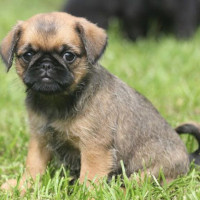Appearance of the Pugwich
|
| The Pugwich has a small to medium-sized body and short, strong legs with small, rounded paws. Their faces can vary in appearance depending on the genetic influence of the parent dogs. The muzzle can vary from the flat face of the Pug to the fine, pointed muzzle of the Norwich Terrier. The eyes are round and dark, sparkling with anticipation. Ears can be erect or triangular and floppy. Sometimes the Pugwich inherits the Pug's black mask and wrinkled skin, but this depends on its genetics. The tail is of medium length and can curl over the back. The short coat can be soft or wiry, and can be a single or double coat. Attractive to look at, gentle in nature and with enough energy for the whole family, this affectionate, sociable dog is a truly loyal companion. |
Temperament of the Pugwich
|
| Playful and friendly, the Pugwich is a lively, inquisitive little dog that makes an ideal companion and loyal pet. They adore children and will happily play with them for days on end. These dogs are quite active and will follow you wherever you go, even if it's just outside to check the mailbox, and they'll treat it as a huge adventure. Their enthusiasm for life is contagious and you'll never be alone with a Pugwich around. Like most dogs, they're ready to please, but can get bored easily, something to remember during training. If it's not fun, it will take longer for your Pugwich to learn, as its concentration will wander. This habit can be frustrating, but a simple remedy is to keep training sessions fun and, when they start to lose interest, switch to a game to liven things up. Lots of praise and small rewards go a long way to getting the Pugwich to do what you ask. These little dogs will warn you when strangers are nearby, but are generally calm dogs. They adapt well to apartment living, but need daily walks to meet their exercise needs. A home with a secure yard will be a haven to explore, and your little watchdog will take possession and get to know every inch of it. The Terrier influence can produce a strong hunting instinct in your Pugwich, so when you're out and about, it would be best to keep him on a leash, as even a low-flying bird is the signal to hunt. With its pretty dark mask, a few gentle wrinkles and winning ways, the Pugwich is a real contender when it comes to a family dog or constant companion. |
Needs and activities of the Pugwich
|
| The Pugwich is an active little dog that likes to be in the know. Whatever you do, they want to help you. Although they get plenty of exercise simply because they're busy, they'll still need a daily walk or two if you have the energy. Keep them on a leash though, as their hunting instincts are high and they can easily run off after a small furry animal and disappear from sight. A daily walk or play in the secure dog park is an ideal way to socialize your dog. As they meet other dogs and people, it builds their confidence and produces a dog with a well-rounded character. Children will love these active little playmates, just teach them to be gentle with a puppy, as rough play can damage small dogs. All in all, the Pugwich is an active, adorable little powerhouse and a loyal, loving companion. |
Maintenance of the Pugwich
|
| The Pugwich will benefit from regular grooming sessions to keep them looking their best. A good brushing once a week should suffice, unless they have the dense double coat of the Norwich Terrier, which will require almost daily brushing. This is the ideal time to check your dog for wounds or infections, and treat him accordingly. One area that needs frequent checking is a dog's ears. These can be infected by an accumulation of debris or foreign bodies such as pods. Gentle wiping with a damp cloth, followed by careful drying of the ear, should keep them in good health. The Pugwich will normally wear its nails naturally during its busy day, but just check if it needs a light trim. Then, a quick brushing of their canine pearly whites will keep their teeth shiny and their breath sweet. |









 English (United Kingdom)
English (United Kingdom)